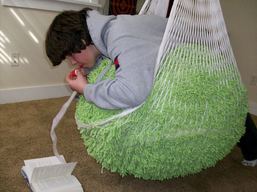Setting Your Child Up For Homework Success!
Sensory Style!
The sensory strategies below apply to ALL children, and are of utmost important for those with sensory differences. After a long challenging day at school, the last thing a child needs is homework...but since I can't do anything about that part, I will do what I can do, which is provide sensory solutions! Two things to keep in mind: 1. The brain and nervous system are still sorting out and processing all of the multi-sensory input from the school day, so insisting on homework to be complete the minute a child gets home is probably the worst thing you can do for the brain. 2. It is critical to give the brain time to sort out and decompress, THEN re-boot the brain by sensory activities to maximize attention to task, executive functioning and cognition, and to make the homework process efficient and a success!
Top 16 Sensory Strategies for Homework!
- Give the child a break! At least 30 minutes of free sensory play when they arrive home from school, and this does not count screen time (That can perhaps be the reward after homework)
- During the 30 minute break, offer various sensory activities, primarily vestibular and proprioceptive
- Also suggest resistive sucking and blowing games prior to homework such as a bubble mountain
- Offer a crunchy or chewy snack during homework or drinking something resistive through a straw, such as a fruit smoothie or even non-dairy yogurt or pudding
- Offer organic chewing gum during homework or another oral sensory tool.
- Be sure homework is complete in a quiet area, not in the kitchen or living room..unless you can be sure it will be quiet and distraction free
- Allow the school work to be done on a clipboard while sitting in a squish box or in another sensory retreat with adequate lighting
- Offer earplugs or noise cancelling headphones during homework (even when in a quiet place) as the sound of the fan or noises outside can be enough to disrupt sensory processing for those who have difficulty filtering out auditory input
- Try using a vertical surface for any written homework, such as an easel or even taping the work to a flat surface on the wall. You can also encourage using a chalkboard or dry erase board for working out math problems and such.
- Use an indoor or outdoor swing or trampoline for working on memory type homework such as studying for a test or for studying a spelling list
- Use a ball chair instead of a standard chair
- Place Theraband or other resistance bands around the base of the chair for pushing and pulling with the legs, or wrap over shoulders for deep pressure and resistive work with the arms. The resistance bands can also be wrapped around the arm of the chair.
- Another alternative is laying prone on elbows for working on homework, especially when reading
- Never allow homework to be done with the TV on in the background
- Offer tools such as a weighted lap pad or vibrating pillow to be used during homework
- And how could I forget, a fidget toy of course!


